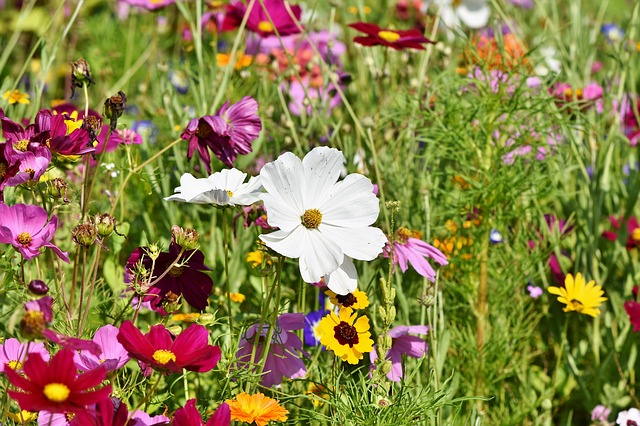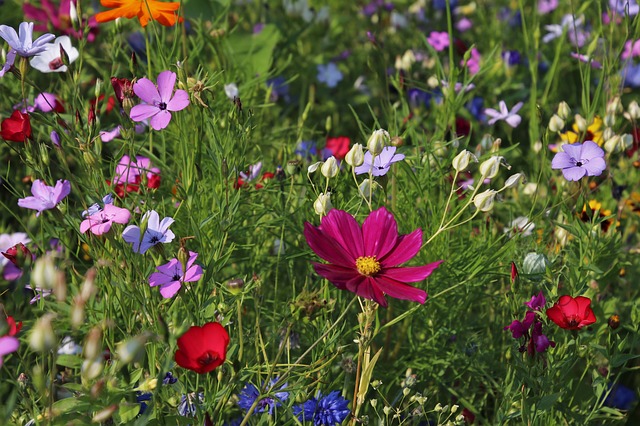Wildflowers

Gardening Question from Mary:
What is the best fertilizer to use on wild flowers for a grave site ,, I would like to plant for my mother,on her grave,and what time of year is best to do this?

Answer from Pat:
It is a lovely idea to plant wildflowers on your mother’s grave. This is a very loving thing for you to do and touched my heart. First, my heartfelt condolence regarding the loss of your mother. I remember how I felt when my own mother passed away. I cried every evening while cooking dinner for a month until she came to me in a dream. She was young and breathtakingly beautiful again, about 40 years old at the height of her good looks, and she laid her head on my pillow next to me and she had a great message for me. After that I didn’t cry any more and I knew she was fine and all was well between us.
Now to answer your questions: No fertilizer is necessary for growing wildflowers unless you have been planting wildflowers in one place for eight to ten years and you have noticed that they have begun doing poorly, which certainly does not apply in this case. Fertilizing wildflowers results in too much green growth and not enough flowers, if any. Wildflowers are wonderful plants since when rains are adequate they can survive and bloom with little care, but the reverse side of that quality is that too much kindness can kill them.
If you live in Southern California, plant Western or California wildflowers and plant these in early November. This is best time to plant wildflowers on your mother’s grave if it is in California. If you live in some other part of the United States, choose seeds of wildflowers for your specific region. For example, if you live in the desert plant desert wildflowers. In most parts of the United States fall planting is the correct time to put in wildflowers. In areas with cold winters, plant wildflowers two weeks prior to the first frost date.
In addition to California wildflowers, I always plant baby snapdragon or Moroccan toadflax (Linaria marocanna ‘Fairy Bouquet’.) It grows well in many parts of the United States. It naturalizes in my garden and comes back yearly with the rains. It is not a pest as is common toadflax or butter and eggs (Linaria vulgaris.) L. vulgaris is invasive in areas with year-round rainfall and should never be planted since it can invade wild lands. It is usually the first wildflower to bloom and lasts a long time.
Prior to planting it is best ot prepare the ground by spreading a 4-inch thick layer of organic soil amendment onto the area to be planted and then work this into the top foot of the soil, if you can, or at least into the top 6 or 8 inches. Most wildflowers grow best in sandy soil, but you may find the soil is not sandy. In any case adding organic soil amendment (compost) will help. (Mixing in organic soil amendment lightens heavy soils and makes sandy soils hold moisture better.)
After preparing the soil then sprinkle the seeds all over the ground as evenly as possible and not using more than the package suggests, since if you over crowd them you will need to thin them out later. After sprinkling on the seeds, rake them lightly into the ground using a garden rake, not a grass rake. If you plan to plant larkspur sprinkle these on last. Raking the seeds into the ground covers them very lightly not deeply, since many wildflower seeds need light to germinate, but especially larkspur. If you plan to plant larkspur sprinkle these on last and don’t rake them in. When first planting, birds are not likely to notice, but in later years if you plant more, birds may remember and eat the seeds. In that case you may need to protect the bed with bird netting the second year. But if you are hoping the wildflowers will seed themselves, try that out. Birds are not likely to get all those seeds.
In a home garden I always recommend sprinkling thoroughly with water from the hose after planting and keeping it up every day until the seeds germinate. This may not be possible for you to do. In your case you will have to rely on automatic sprinklers if there are any or if not you will have to rely on the rains. I hope the rains will be good and that you will have excellent success.
Good luck with this and once again my deepest condolences over the loss of your mother, though I am sure she will be a good angel for you helping you and yours in your life and bringing many good things your way.


Thank you ever so much. I may do a small area in the spring time.Chicago’s winters can be brutal.
Now that I know where you live I can recommend you plant wildflowers of the midwest. It is fine to plant midwestern varieties in spring as you plan to do but you will not get all the varieties to grow that way. Many seeds will not sprout when planted in spring since they need to undergo a cold winter in order to germinate. It might be better if you planted the seeds sometime this fall. If on the other hand you prefer to plant in spring, put the seed packet in the freezer for a couple of nights before planting. Then plant right away. This might help.
The reason I suggested fall planting is that seeds of many wildflowers native to a harsh, northern climate need cold winter temperatures, including snow, ice, sleet, rain, and whatever else happens in order to germinate and grow. Without these conditions they cannot sprout. So though it sounds best to you as a human being to be warmly indoors in winter that is not necessarily true for wildflower seeds since some of them would much prefer to be out there in the elements as nature intended when she released them from seed pods and they fell to the ground. Think of the prairie. Many flower seeds are on the ground now in late August and they will stay there all winter under the snow and all through the repeated thawing and freezing that occurs in spring. These conditions gradually break through their hard seed coats and then later on in spring when temperatures rise, they will be able to sprout and grow.
In frost-free zones of California we need to freeze some seeds before planting in order to make them grow, but some midwest seeds need even more than simply freezing. Many need scarification prior to planting by scrubbing them between two sheets of sandpaper, or by nicking them with a knife. You could not open up the packet of mixed seeds and expect to know which ones need this treatment. When you plant in fall the winter climate does the scarification for you.
I suggest you purchase the seeds now. Mix them around well and divide into two halves separate envelopes. Plant half the seeds in September or October and then wait until next year and plant the rest of them in May. That way you would be likely to have the greatest success.
We have a wonderful View of the lake the hill across from us has been burned by the fire I would love to be able to sow wildflowers in the fall and name the hill for the fire fighters not sure I can do this but I would like to try do you have any ideas where I could get pounds of wildflower seeds at a reasonable price
My experience with wildflowers is that Mother Nature plants the seeds. Or rather, she planted them centuries ago and they are still there. Usually after a wildfire, if there is sufficient rain, a plethora of wildflowers including or often dominated by long-dormant bulbs, comes to life and the scar where the wildflower apparently killed all life, comes back miraculously to life. The seeds are already there but have been buried for years under chaparral and non-native grass. This is one of the miracles of nature that is especially stunning in California.